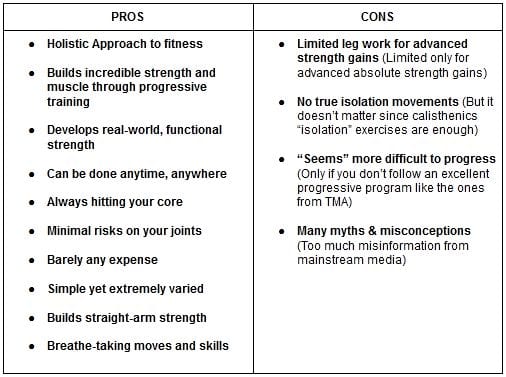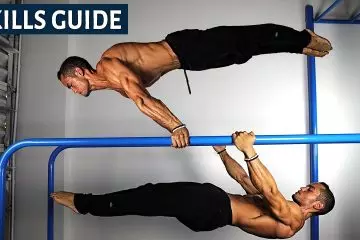As an Amazon Associate, I earn from qualifying purchases.
This article from the teamkathycarter website discusses Calisthenics Disadvantages.
Calisthenics, a form of bodyweight training, can lead to overuse injuries and limited muscle growth due to a lack of resistance. However, it offers many benefits, including increased flexibility and improved body control.
However, it also comes with its own set of disadvantages. Without additional weights, calisthenics may lead to limited muscle growth and strength. Another drawback is the potential for overuse injuries, as the same movements are repeated frequently. Additionally, calisthenics can also be challenging for individuals looking to build significant muscle mass.
Despite these drawbacks, many people still enjoy the simplicity and accessibility of calisthenics as an effective form of exercise. Understanding both the advantages and disadvantages can help individuals make informed decisions about incorporating calisthenics into their fitness routines.
Limited Muscle Growth Potential- Calisthenics Disadvantages
Calisthenics may limit muscle growth potential due to the lack of heavyweights. Individuals seeking significant gains may experience challenges with calisthenics training. To maximize muscle development, it is essential to incorporate weight training.
Limited Muscle Growth Potential
Calisthenics, while effective for improving strength and endurance, has certain limitations when it comes to muscle growth potential. This form of exercise primarily utilizes bodyweight resistance and may not provide the same magnitude of muscle hypertrophy as traditional weightlifting. Understanding these limitations can help individuals make informed decisions about their fitness routines.
Bodyweight Resistance
When engaging in calisthenics, the resistance primarily comes from one’s own body weight. While this can be effective for building foundational strength, it may not provide enough resistance to stimulate significant muscle growth, especially for individuals who have already developed a certain level of strength. The body’s adaptation to the resistance can lead to a plateau effect, hindering further muscle development.
Plateau Effect
With calisthenics, individuals may reach a plateau where their muscles no longer see significant growth or development. This occurs when the body becomes accustomed to the level of resistance provided by bodyweight exercises, making it challenging to elicit further gains in muscle mass. Overcoming the plateau may require advanced calisthenics variations or incorporating additional resistance through equipment, but even then, the potential for muscle growth may be limited compared to traditional weight training methods.

Credit: themovementathlete.com
Challenge With Progressive Overload- Calisthenics Disadvantages
While calisthenics offers numerous benefits for both beginners and advanced athletes, it comes with its fair share of challenges. One of the main difficulties faced in calisthenics training is the challenge of maintaining progressive overload. Progressive overload is a training principle that involves gradually increasing the intensity, duration, or resistance of an exercise in order to continue making gains in strength, endurance, and muscle growth.
Equipment Dependency- Calisthenics Disadvantages
Unlike weightlifting or other forms of exercise that rely on external resistance, calisthenics primarily utilizes the body’s own weight. However, this can also be a disadvantage when it comes to progressive overload. Without access to additional equipment, it becomes challenging to increase the resistance and continue making progress.
Moreover, for exercises that do require equipment such as pull-up bars or resistance bands, individuals may face limitations if they don’t have access to these items. This can hinder their ability to perform certain movements or progress in their training.
Difficulty Tracking Progress- Calisthenics Disadvantages
In calisthenics, it can be more challenging to track progress compared to other forms of training. While weightlifting allows individuals to easily track their progress by gradually increasing the weight lifted, calisthenics relies more on mastering complex movements and increasing repetitions. This makes it harder to assess and measure progress accurately.
| Common difficulties in tracking progress: |
|---|
|
Without a clear way to track progress, it can be harder for individuals to stay motivated and determine if they are effectively implementing progressive overload in their calisthenics routine.
In conclusion, while calisthenics has numerous advantages, such as being accessible and requiring minimal equipment, it also presents challenges when it comes to maintaining progressive overload. The lack of equipment options and difficulties in tracking progress can hinder an individual’s ability to continue making gains in strength and muscle growth. However, with proper planning, adjustment of variables like intensity and volume, and a focus on mastering movement patterns, these challenges can be overcome in the pursuit of calisthenics excellence.
Risk Of Plateau And Monotony- Calisthenics Disadvantages
Calisthenics enthusiasts face challenges with the risk of plateaus and monotony, which can hinder progress and motivation. To overcome these disadvantages, incorporating a variety of exercises and training methods can help break through barriers and keep workouts engaging.
Calisthenics, with its focus on bodyweight exercises, can be an incredibly effective and satisfying workout routine. However, it is not without its disadvantages. One significant drawback is the risk of plateau and monotony. Let’s dive into the reasons why this can happen.
Limited Exercise Variations- Calisthenics Disadvantages
One reason you may encounter a plateau in your calisthenics progress is the limited exercise variations available. While there are numerous bodyweight exercises to choose from, the options can be somewhat restricted compared to traditional weightlifting. This limited variety can make it challenging to continually challenge and engage your muscles.
The absence of equipment often means that calisthenics routines primarily revolve around exercises that target major muscle groups, such as push-ups, pull-ups, squats, and lunges. While these exercises are effective, they primarily focus on the same muscle groups, leading to reduced overall muscle development over time.
Repetitive Training- Calisthenics Disadvantages
Another factor that can contribute to plateauing and monotony in calisthenics is repetitive training. With calisthenics, repetition is key to building strength and skill. However, this repetition can become monotonous and less effective in the long run.
Performing the same exercises day in and day out can lead to a lack of progress and diminishing returns. Your body becomes accustomed to the movements, making the exercises less challenging over time. As a result, your muscles may not grow or adapt as much as they would with more varied workouts.
To overcome this limitation, it is crucial to incorporate additional challenges and variations into your calisthenics routine. This might include adding resistance bands, progressing to more advanced variations of exercises, or introducing new movements altogether.
Incorporating Variety For Continued Progress
To prevent plateauing and combat the monotony, it is essential to seek different exercise variations and techniques within the realm of calisthenics. By incorporating variety into your workouts, you can ensure continued progress.
One approach is to explore calisthenics progressions, which are variations of the basic exercises that increase in difficulty over time. Progressions provide a structured way to challenge your muscles and keep your routine fresh and exciting. As you master one variation, you can move on to the next, constantly pushing your limits and seeing improvements.
Moreover, supplementing calisthenics with other forms of training can help break the monotony and provide a well-rounded workout. Including activities such as yoga, plyometrics, or conditioning exercises can add variety and stimulate different muscle groups, helping you avoid the dreaded plateau.
In conclusion, while calisthenics offers numerous benefits, it is not without its disadvantages. The risk of plateau and monotony is a key drawback that can hinder progress over time. By actively seeking out new exercises, incorporating progressions, and diversifying your training, you can overcome these challenges and continue to make progress in your calisthenics journey.
Injury Risks- Calisthenics Disadvantages
When engaging in calisthenics, it’s crucial to be aware of the potential injury risks. While calisthenics offers numerous benefits, it’s essential to understand the potential drawbacks to ensure a safe and effective workout routine.
Overuse Injuries- Calisthenics Disadvantages
Performing repetitive movements in calisthenics, such as push-ups, pull-ups, and squats, can lead to overuse injuries. Constantly engaging the same muscle groups without sufficient rest can result in strains, sprains, and other overuse-related injuries.
Lack Of Proper Form Control- Calisthenics Disadvantages
Without proper form control, individuals practicing calisthenics are susceptible to injury. Failure to maintain correct posture and alignment during exercises can lead to muscle imbalances, joint stress, and an increased risk of strains and sprains.
Struggles With Specific Muscle Targeting
Struggles with specific muscle targeting can be a disadvantage of calisthenics, hindering overall muscle development. This limitation may require additional exercises or equipment to effectively target specific muscle groups.
Isolation Exercises Difficult
Performing isolation exercises in calisthenics can be challenging due to the lack of equipment.
Uneven Muscle Development
Without proper equipment, calisthenics may lead to uneven muscle development.
Credit: www.vitalscend.com
Challenges For Advanced Strength Levels
Challenges for Advanced Strength Levels:
Heavy Weight Requirements
Calisthenics at advanced levels may necessitate heavyweights for effective muscle building.
Additional Resistance Demands
- Advanced calisthenics movements may require extra resistance beyond body weight.
- Resistance bands or weighted vests become essential for progression.
Time-consuming Nature Of Calisthenics
Calisthenics, while being an effective workout form, comes with its fair share of disadvantages. Understanding the time-consuming nature of calisthenics is essential for individuals considering this form of exercise.
Extended Workouts
Calisthenics routines often require a considerable amount of time to complete. These workouts typically consist of multiple sets and repetitions to effectively target different muscle groups. Consequently, individuals committing to calisthenics may find themselves spending longer durations on their daily exercise routines compared to other forms of workouts.
Complex Skill Mastery
Unlike traditional gym exercises, calisthenics involves mastering complex bodyweight movements such as handstands, muscle-ups, and human flags. Achieving proficiency in these movements demands patience and dedicated practice, leading to a time-consuming journey toward skill mastery. This can be a significant drawback for individuals seeking quicker or more straightforward fitness solutions.
Social And Competitive Limitations
Calisthenics, with its emphasis on bodyweight exercises, offers a myriad of benefits such as improved strength, flexibility, and body control. However, it is important to also acknowledge the social and competitive limitations that accompany this form of training. Understanding these limitations can provide valuable insights for individuals considering calisthenics as their primary workout regimen.
Lack Of Group Dynamics- Calisthenics Disadvantages
In traditional gym settings, group dynamics play a significant role in motivation and social interaction. Sadly, calisthenics is often perceived as an individual pursuit, lacking the same sense of camaraderie found in team sports or fitness classes. This can lead to isolated training sessions that lack the engagement and support obtained from working out with others. The absence of group dynamics may take away the element of competition and motivation that some individuals thrive on.
Limited Competitive Options- Calisthenics Disadvantages
A primary disadvantage of calisthenics lies in its limited competitive options. While sports such as weightlifting or running offer numerous formal competitions at various skill levels, calisthenics competitions are relatively scarce. This scarcity restricts those seeking to test their abilities and measure their progress against other athletes. The lack of competitive events deters individuals who thrive on the competitive nature of traditional sports, leaving them with fewer outlets to demonstrate their skills and achievements.
Frequently Asked Questions about Calisthenics Disadvantages
Is There Any Side Effects Of Calisthenics?
The side effects of calisthenics are minimal when done correctly. Overtraining can lead to strains and muscle imbalances. Ensure proper form and rest.
Who Should Not Do Calisthenics?
People with untreated injuries or underlying medical conditions should not do calisthenics. Always consult a healthcare professional before starting any new exercise routine.
What Are The Advantages And Disadvantages Of Calisthenics?
Advantages of calisthenics include cost-effective workout and improved body strength, flexibility, and coordination. Disadvantages may include limited muscle mass gains and advanced difficulty progression.
Which Is Healthier Gym Or Calisthenics?
Both gym workouts and calisthenics have their health benefits. Gym workouts offer a variety of equipment, while calisthenics focuses on bodyweight exercises. Both can improve strength and endurance, so the healthier option depends on individual preferences and goals.
Last Word about Calisthenics Disadvantages
To sum up, calisthenics can have its downsides, such as the potential for overuse injuries and limited opportunities for progressive overload. However, with proper planning and variation, these disadvantages can be mitigated. By considering individual limitations and seeking balanced routines, anyone can still enjoy the many benefits of calisthenics training.
As an Amazon Associate, I earn from qualifying purchases.

